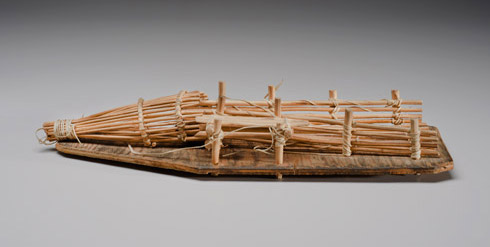About the Artifact

© Canadian Museum of Civilization, VI-I- 51, Photo Marie-Louise Deruaz, IMG2010-0112-0008-Dm
“A side-stream trap, used mainly on small tributaries of the main river — the Peel in this case — but sometimes also used in small eddies of the main river. Customarily made in two sizes, one about three feet [91 cm] long, for herring, and one five feet [1.5 m] long, for whitefish and char. It is used with a fish fence, or weir, in which it is set.
The fish trap is set twice annually, once early in the summer, for the main migration, and again late in the summer, to catch the return drift of spawned-out fish. The early fish are ‘put up’ — split and sun- or smoke-dried. The late fish are generally ‘pitted’; i.e., thrown into pits, five or six feet [1.5 to 1.8 m] deep, dug into the permafrost and floored and later covered with spruce boughs. The pit fish are left to rot partially. Pits are covered with heavy logs to preserve contents from dogs and other animals. Pit fish are dog feed. Probably pit fish were little used in pre-contact times because there were few dogs. However, the use of fish traps and of pit fish did overlap by perhaps half a century in the Peel River area.”
— Richard Slobodin, 1963–1964
“The fish-camp leader had considerable executive importance in the construction and maintenance of the fish traps. There were seldom more than two fish weirs at any fishery: their construction each summer was directed by the camp leader. It was the leader’s responsibility to arrange close and vigilant watch for the arrival of schools of fish from downstream and, in the late summer, the arrival of the first floating ice from upstream. A middle-aged informant has described being summoned from sleep in his boyhood by the shouts of the fish-camp leader, calling everyone to the work of dismantling the weir in a great hurry in order to save it from destruction by the ice”.
— Richard Slobodin, 1962